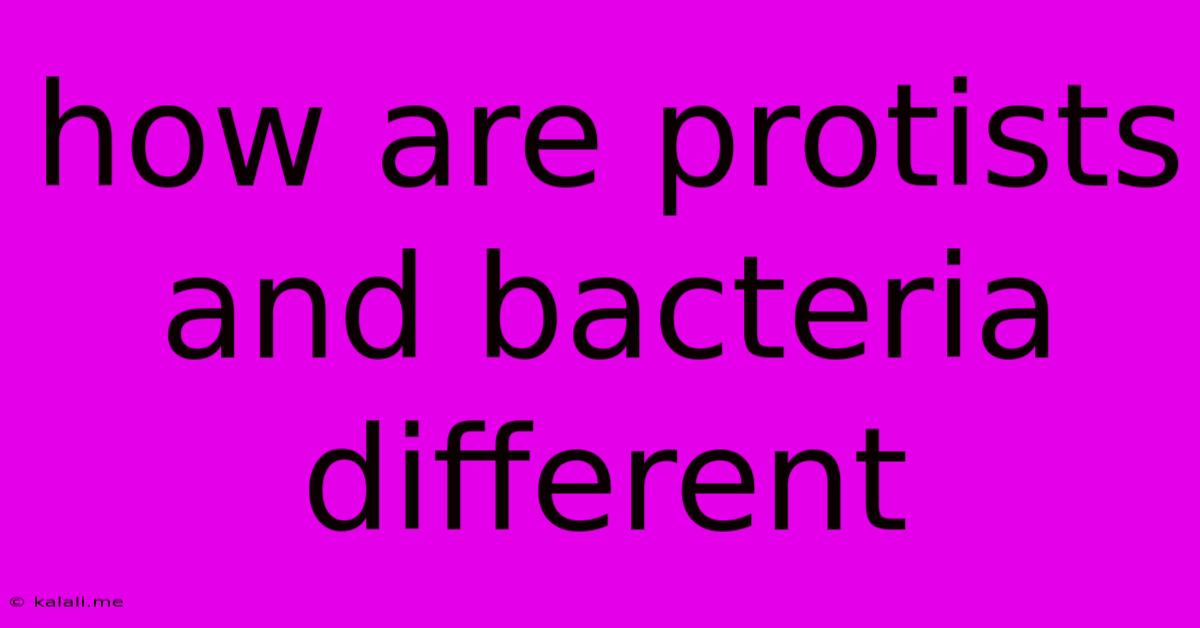How Are Protists And Bacteria Different
Kalali
Jun 14, 2025 · 3 min read

Table of Contents
How Are Protists and Bacteria Different? A Comprehensive Comparison
Protists and bacteria are both microscopic organisms, often lumped together in the broad category of "microbes." However, these two groups of life are vastly different in their cellular structure, evolutionary history, and ecological roles. Understanding their differences is crucial for appreciating the diversity of life on Earth. This article delves into the key distinctions between protists and bacteria, exploring their cellular organization, genetic makeup, and metabolic processes.
Key Differences Between Protists and Bacteria:
The most fundamental difference lies in their cellular structure:
-
Cellular Complexity: Bacteria are prokaryotes, meaning their cells lack a membrane-bound nucleus and other membrane-bound organelles. Protists, on the other hand, are eukaryotes, possessing a true nucleus enclosed by a membrane, as well as other membrane-bound organelles like mitochondria, chloroplasts (in some), and endoplasmic reticulum. This complex cellular organization reflects a higher level of evolutionary advancement.
-
Genetic Material: Bacterial DNA is typically a single, circular chromosome located in the cytoplasm. Protists have multiple linear chromosomes housed within their membrane-bound nucleus. This difference in genetic organization contributes to their differing complexity and reproductive strategies.
-
Size and Structure: Bacteria are generally smaller and simpler in structure than protists. Protists exhibit greater morphological diversity, ranging from single-celled amoebas to complex multicellular algae. This size and structural variation reflects their diverse lifestyles and ecological niches.
-
Ribosomes: Although both bacteria and protists possess ribosomes (the protein-synthesis machinery), the size and structure of these ribosomes differ significantly. Bacterial ribosomes are smaller (70S) than those of protists (80S). This difference is exploited in the development of certain antibiotics which target bacterial ribosomes without harming eukaryotic cells.
Metabolic Diversity:
Both bacteria and protists exhibit a wide range of metabolic strategies, but there are some key distinctions:
-
Photosynthesis: While some bacteria perform photosynthesis (like cyanobacteria), many protists also engage in photosynthesis, with diverse photosynthetic pigments and strategies. Algae, a major group of protists, are crucial primary producers in many aquatic ecosystems.
-
Respiration: Both bacteria and protists can be aerobic (requiring oxygen) or anaerobic (not requiring oxygen), reflecting their adaptation to various environments. The specific metabolic pathways involved, however, can differ significantly between the two groups.
-
Nutrition: Bacteria exhibit a wide variety of nutritional strategies, including photoautotrophy, chemoautotrophy, and heterotrophy. Protists similarly exhibit diverse nutritional modes, including photoautotrophy (like algae), heterotrophy (like amoebas), and mixotrophy (combining both).
Ecological Roles:
Both bacteria and protists play essential roles in various ecosystems:
-
Decomposition: Bacteria are crucial decomposers, breaking down organic matter and recycling nutrients. Some protists also contribute to decomposition processes, particularly in aquatic environments.
-
Nutrient Cycling: The metabolic activities of both bacteria and protists are critical for nutrient cycling in ecosystems, influencing the availability of essential elements like nitrogen and phosphorus.
-
Symbiosis: Many bacteria and protists form symbiotic relationships with other organisms, sometimes beneficial and sometimes harmful. For instance, some protists live in the guts of animals aiding in digestion, while other bacteria can cause disease.
In Summary:
While both bacteria and protists are microscopic organisms, they differ fundamentally in their cellular complexity, genetic organization, and metabolic strategies. Bacteria are prokaryotic cells lacking membrane-bound organelles, while protists are eukaryotic cells with a nucleus and other organelles. Understanding these differences is vital for appreciating the remarkable diversity of life and the ecological roles these microscopic organisms play. Further research continues to reveal the intricacies of both bacterial and protist biology, constantly expanding our understanding of the microbial world.
Latest Posts
Latest Posts
-
Example Of Solid Dissolved In Solid
Jun 14, 2025
-
Air Pressure At Sea Level Is Equal To
Jun 14, 2025
-
What Is The Opposite Of Reluctant
Jun 14, 2025
-
Brass Is A Mixture Of What
Jun 14, 2025
-
Which Of The Following Are Pure Substances
Jun 14, 2025
Related Post
Thank you for visiting our website which covers about How Are Protists And Bacteria Different . We hope the information provided has been useful to you. Feel free to contact us if you have any questions or need further assistance. See you next time and don't miss to bookmark.